

 (252x320).jpg) |
Volume 58 - Number 1 January - 2014 (Current issue) ISSN 0019-5499 |
Effects of yoga training and detraining on physical performance measures in prepubertal children – a randomized trialCrystal D’souza and Sandhya T Avadhany |
Purpose of the study was to evaluate the effect of yoga training and detraining on physical performance measures in pre-pubertal (7-9 year old) school going children. Subjects were randomized to two groups – yoga group and Physical exercise (PE) group after the baseline assessment. All the subjects were assessed for strength, endurance, whole body endurance through 20 meter shuttle and physical fitness, at 3 time points – Baseline, 3 months Post intervention and 3 months after detraining. The results suggest that the improvement in the physical performance is largely by the increase in the respiratory muscle strength in the yoga group. In conclusion, the study presents the efficacy of yoga to improve strength, endurance, whole body endurance and aerobic capacity with 3 months of training in the pediatric group. However, the effect of the training does not last after 3 months detraining. |
Physical inactivity is a modifiable risk factor for cardiovascular disease, cancer, osteoporosis and a widening variety of other chronic diseases. Physical exercise is considered an acceptable method for improving and maintaining physical and emotional health. Multiple studies have shown that people who maintain appropriate fitness, using judicious regimes of exercise and weight control have additional benefits of prolonged life (1). The conventional exercises (endurance exercises like walking, jogging, running, swimming, cycling, etc), which give stress on cardiovascular and respiratory system, are very popular. On the other hand, ancient yogic exercises which have been claimed to have a holistic approach towards good health is getting popularity all over the world (2). The focus of the present study is effect of yoga on physical fitness which is a long term predictor of over all good health in adults (3). It is known, anatomical and physiological response to sufficient physical activity leads to improved fitness (4). Physical activity is considered as a key factor for a healthy physical and mental development of children currently, the increasing prevalence of overweight/ obesity in children make children at risk of developing several chronic diseases later in life, also because children who are not physically active are unlikely to become so in adulthood (5). Yoga has been reported to improve the strength, endurance, vo2 peak, which are the components of the physical fitness (6, 7, 8, 9, and 10). Most of the studies are conducted on the adolescents and adults, non randomized trials, and sparce studies on underprivileged prepubertal age group. Therefore, the aim of the present study is to investigate the effects of Yoga on strength, endurance, whole body endurance and aerobic capacity through randomized study in pre pubertal school going children. |
Design The study used a randomized design. Randomization was performed by a computer-generated list. (Randomization was done after base line assessment). Randomized design with eligible children being randomly assigned to one of the two study groups were made at one time that allowed for the active intervention of yoga and physical exercise to begin at the same time. Stratified randomization was done by gender repetition using RALLOC software. Intervention The ierventions were given by trained yoga qualified
teachers and Physical Education trained teacher.
The children were randomly assigned to either yoga
or a physical-education (PE) group. Both the
interventions were given for 45 minutes at the same
time in the afternoon but were at two different
locations on the school premises. The interventions To assess the detraining effect of intervention, the intervention was suspended for 3 months where none in the groups followed any structured activity, nor they attended any structured intervention, they did play for fun or for keeping them busy or going for vacations. Assessments were done immediately after children rejoined the school after vacations. |
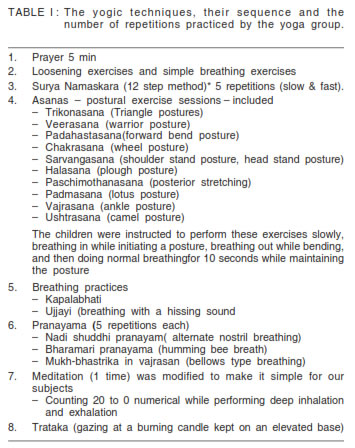 |
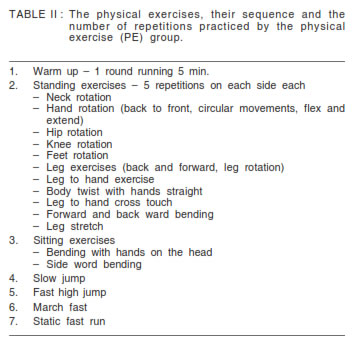 |
Physical activity levels (PAL) questionnaires were administered to all the subjects. However, we could not consider it; the information by 7-9 year old would be invalid and not advisable. We did this exercise only to have a gross idea of their physical activity levels and found that both the groups were similar in their activities as the subjects spend most of their time in the school. Participants The sample size consisted of hundred, 7-9 year old healthy (as assessed by clinical examination by medical professionals) school going children hailing from a socio-economically disadvantaged background. All participants were recruited from a single school in Urban Bangalore, India. The children gave oral assent while the parents/legal guardian provided written informed consent. The school also provided written permission to conduct the study on its children, on the school premises. The study was approved by the Institutional Ethical Review Board of St. John’s National Academy of Health Sciences. Children underwent a physical examination and apparently healthy children with no history of chronic diseases, physical or mental handicap and not severely undernourished (<-3SD for weight for age and -3SD height for age z scores of the National center for health statistics/WHO standards) (11) were invited to participate in the study. Assessments Socio-demographic information was obtained from school record. There were no significant differences in any of the socio-demographic characteristics between the groups. Majority of parents were employed as daily wage earners. Mean total family income was 49641471 Indian rupees (equivalent to US $ 100). Approximately one third of the mothers were uneducated. Physical performance – The primary outcome measures were whole body endurance and aerobic capacity. Secondary outcome measures were muscle strength in three groups of muscles-forearm, calf muscle and respiratory muscle and endurance in the forearm and calf muscle. Whole body endurance and aerobic capacity were measured using the standardized and established procedure of 20-m shuttle test (12). VO2 peak (peak oxygen uptake) was estimated from the 20-m shuttle and was calculated using prediction equations (13). The whole body endurance was calculated using the number of laps completed during the 20-m shuttle test. The 20m shuttle test was performed in groups of between 3 to 5 participants to improve motivation and maximize performance. Strength was measured in three group of muscle – fore arm, calf muscle and respiratory muscles. And static endurance was measured in forearm and calf muscle only. Maximal handgrip strength was measured using a
GRIP D hand dynamometer in both, dominant and
non-dominant arms. The subject was asked to hold
the grip dynamometer by the side and slightly away
from the body so that it is not resting against the
thigh. The measurement for each arm was taken
three times alternately, resting about a minute
between contractions on the same side. Muscle
strength was recorded as the best (highest) value
for the dominant and non-dominant sides. Static
forearm endurance was determined by noting the
maximum time (seconds) for which the subject could
maintain 50% of Maximum Voluntary Contraction.
Calf muscle strength was measured using a
dynamometer (developed at St.John’s Medical
College in the Physiology Department) which had a
digital display. The subject was asked to sit
comfortably on a chair and was asked to place the
foot on the while the thighs were fixed or strapped.
The calf muscle was felt and checked to confirm
that the gasteronemious muscle was relaxed. Then Anthropometry Body weight was recorded with subjects wearing their school uniform to the nearest 0.1 kg using a digital weighing scale (Salter Kent, England), while height was recorded to the nearest 0.1 cm using a locally made and validated stadiometer (Biorad, India) Pulmonary function test Lung functions were measured using Laptop-based Micro-Quark PC (computer) based Spirometer (COSMED–Italian Company). The system was calibrated everyday with a 600-ml syringe. Participants were called in batches and were explained and demonstrated the correct technique to the subjects how to perform the test (17). Disposable mouth piece given to children and were asked to practice to blow into the mouth piece. An antiseptic procedure was followed by the children to insert the mouth piece. Care was taken to teach the participants on closing the lips around the mouth piece and on placing of the nose-clip during the procedure. Each subject was provided 15–20 trials, of which 3 best trials were selected and, among the 3 highest readings, the best (highest) was selected as the representative of that test. Statistical analysis Data are expressed as Mean+SD. Intergroup comparisons were done using independent t-test and at baseline to check the homogeneity of the groups. Comparisons within the group were done by paired t-test for both the groups.The endurance measures were not normally distributed and, Hence, log transformed data was used in the analysis. Our study consists of three time points – baseline, post intervention (3 months after the intervention) and follow up (3 months after the cessation of the intervention, this period had no intervention. Our interest was – first, to evaluate the effect of intervention. So, ANCOVA was performed to compare the groups (yoga and PE) at post intervention adjusting for the baseline values and controlling for age to observe any significant difference between the two interventional groups. Second, interest was to know the sustained effect of the intervention. |
Of the 100 children enrolled in the study, 91 children completed assessments at all the 3 time point) both genders were almost equally distributed (boys=45), (girls=46). The mean age of the sample was 7.9+0.9 yrs. The mean height, weight and BMI of the sample were 1.21+0.06m, 20.5+3.1Kg and 13.8+1.1 respectively (Table III). Strength measures of 3 groups of muscles are tabulated in Table IV. The increase in the respiratory pressures was highly significant in both the groups immediately post intervention. Although both the groups were not significantly different, yoga seems to have performed better. A non significant, decrease in the values of MIP and MEP was observed in both the groups after 3 months of cessation of the intervention, However they did not regress to the baseline values. Fore arm strength in both dominant hand and non dominant did not increase significantly post intervention in yoga and PE group. We observed a non significant increase in both the dominant and non dominant fore arm strength at follow up in both the groups. Calf muscle strength in both Right and Left leg increased significantly immediately after intervention in both the groups and continued to increase significantly even after the cessation of the intervention in yoga and PE group. Although, PE group seemed to have performed better than the yoga group in both the legs, both the groups were not significantly different at post intervention and the follow up assessment. Endurance was measured only in forearm and calf muscle (Table V). Dominant forearm endurance increased significantly |
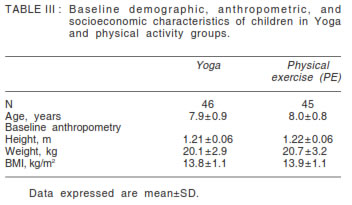 |
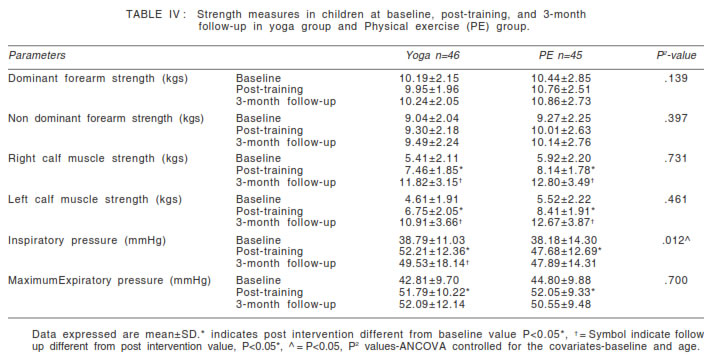 |
 |
only in the PE group post intervention and a trend of increase was observed in the yoga group. The dominant forearm endurance showed a significant increase in the follow up assessment in both the group but this sustained effect was not significant. Non dominant for arm endurance did not change significantly post interventions as well at follow up in both the groups. Calf muscle endurance increased significantly in both right and left leg post intervention. However, the values regressed significantly towards the baseline after the cessation of the intervention. The whole body endurance and VO2 max increased significantly in both the groups post intervention. We observed a non significant sustained effect in both the parameters in the follow up assessment (Table V) .Maximum heart rate recorded at exhaustion in |
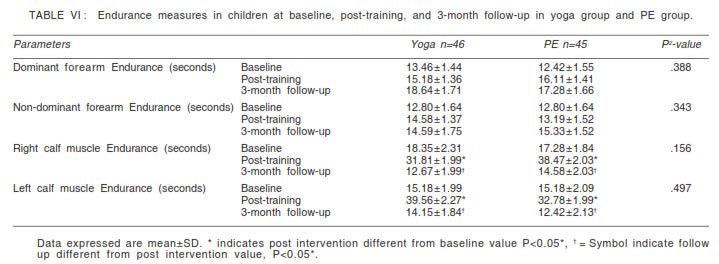 |
20 meter shuttle test decreased significantly in both the groups at post intervention and follow up assessment in both the groups. FVC and FEV1 increased significantly post intervention in both the groups (Table V). However, there were no significant differences between the two study groups in FVC, FEV1 at post-intervention after adjusting for height and age at baseline measure. Significant increase was observed in FVC and FEV1 in both the groups at follow up after 3 months cessation of the |
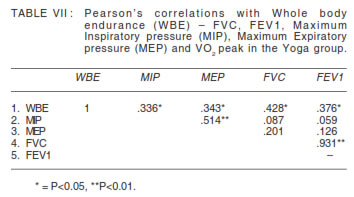 |
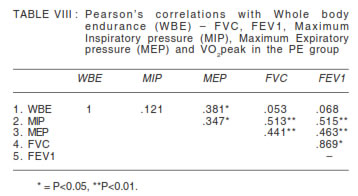 |
intervention. The study observed a significant correlation with Whole body endurance, MIP and MEP in the yoga group (Table VII) where as the PE group showed a significant correlation only with MEP and Whole body endurance (Table VIII). |
The data demonstrates that 3-months of yoga intervention improve whole body endurance and predicted aerobic capacity. The improvement observed in the VO2 peak in the present study in the yoga group can be attributed to surya namskara (10) and the better economy of breathing by the breathing practices in the yoga group (18). The improvement in the whole body endurance can be attributed to 12 step Surya namaskara, which was a section in our yoga intervention, involving static stretching and slow dynamic component with optimal stress on cardiorespiratory which is in accordance with the study conducted by Bhuktar MVet al (10). The whole body endurance increased significantly, can be largely explained by increase in expiratory muscle strength in the PE group where as in the yoga group the improvement in the whole body endurance can be explained by the significant increase in both inspiratory muscle strength and Expiratory muscle strength. This finding is supported by the observed significant increase in FEV1 and FVC in the yoga group post training. Insignificant improvement was observed in whole body endurance and aerobic capacity after 3 months cessation of the interventions in both the groups. The cardio respiratory parameters, Maximal heart rate attained during 20 meter shuttle, forced vital capacity, forced expiratory volume at 1 second improved significantly immediately after 3 months of intervention and as well as after 3 months detraining period. In accordance with the other evidence, our results showed a major improvement in inspiratory muscle strength in both the study groups (7, 16). However the effect of yoga was higher when compared to PE group, this improvement can be attributed to the breathing exercises and pranayama performed by the yoga group. Studies have shown that increase in the respiratory muscle strength improves the respiratory mechanics while the improvement observed in the expiratory muscle strength increases the force of expiration (FEV), reducing the obstruction during expiration (17). Effect of yoga on calf muscle strength and endurance is unknown. A significant improvement was observed in the calf muscle strength and endurance post intervention in both the groups. However, PE seems to have better effect in this parameter. The improvement in the yoga group can be attributed to several standing yogasansa, performed by the subjects, which are powered to stretch and strengthen the calf muscles by applying load (body weight) on the legs namely vrikshasana (tree pose), trikonasana (triangle posture), garudasana (Eagle pose). Halasana (plow pose), Sarvangasana (shoulder stand) are inverted asanas, work by reversing the effects of gravity and helps promote blood circulation and reduces the venous pressure in the legs. Exercises performed by the PE group like jogging, marching, use body weight as resistance, would produce more vigorous impact on the calf muscles than yoga because of the type of exercise and this would have contributed to the higher strength and endurance in the PE group subjects. The intense gain of strength in children is due to enhanced motor unit activation of the trained muscles and muscle hypertrophy (18). However, in the young ages and strength gains can be observed without any change in the muscle mass. Training induced strength gains appear to decay during detraining. However, the maturational process makes the strength reduction in the detraining period less evident (19). In the present study the detraining effect on the calf muscle strength seems to be negligible, thus the data shows a significant increase even after the cessation of intervention for 3 months in both the groups. Our study observed a steep drop in the calf muscle endurance in both the groups after the detraining period which can be as the result of insufficient stimulus during detraining period leading to decrease in capillary density and the reductions in oxidative enzymes, further reduction in mitochondrial ATP production (20). In conclusion, the study presents the efficacy of yoga to improve physical performance with 3 months of training in the pediatric group. However, the effect of the training does not last after the cessation of the training. The significant sustained effect observed in the VO2 peak in both the groups can be attributed to the improved respiratory muscle strength and lung capacities. Strength of the study The study was conducted on a middle childhood group
(7-9 years) which is sparsely explored. Although,
the immediate effect of 3 months of yoga training is
known the detraining effect of yoga was unexplored.
Thus, our study has contributed to the pool of
knowledge, the minimum duration of yoga training
required to show a significant improvement in
strength, endurance, whole body endurance and
aerobic capacity and also the detraining effect of
yoga on all the above parameters. Further validation
is required in this arena with a true control group
which lacked in our study. |
|